“I feel like every song has a tapping lick at some point!”: Wolfgang Van Halen on embracing solos – and his dad’s iconic gear – for the boundary-pushing Mammoth II
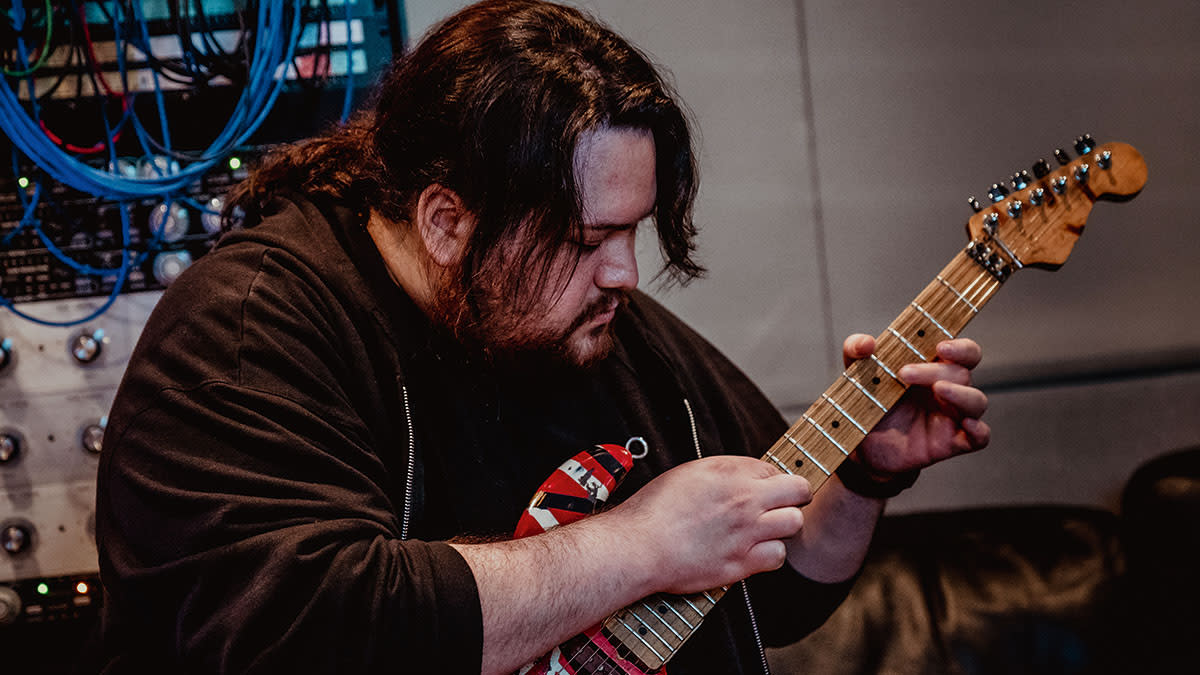
- Oops!Something went wrong.Please try again later.
- Oops!Something went wrong.Please try again later.
- Oops!Something went wrong.Please try again later.
Wolfgang Van Halen is a happy man. On a warm summer’s day, he has just performed an acoustic set with his band Mammoth WVH for the very first time – for a select audience at the new Fender headquarters in London’s West End.
“I think it went well!” he grins, tying his hair back to uncover his eyes. “I usually write things on acoustic, so that’s kinda where all my ideas start. It was different but also a bit familiar.”
There is, of course, a lot of gear in this place, which houses showrooms for Fender’s other music brands – from Jackson, Squier and Gretsch to Charvel, PreSonus and EVH.
Here, you can find instruments and amps of all shapes and colours, catering for just about every kind of guitar sound you can possibly imagine, from vintage-style semi-hollows through mini tweeds to seven-string war machines via high gain stacks.
But as a laidback, easy-going guy, Wolfgang tells Total Guitar: “Today I was just using whatever guitar they gave me. I wasn’t too fussy; whatever works!”
The three-song acoustic set began with Another Celebration At The End Of The World, the lead single from new album Mammoth II, which saw Wolf executing a second-string tapping lick on the third, fifth, eight and tenth frets to spell out the Eb minor pentatonic scale on the Fender Paramount acoustic in his hands, tuned half a step down.
He then led the four-man band through another new single, Like A Pastime, before closing with a cover of the Foo Fighters hit My Hero in tribute to the late Foos drummer Taylor Hawkins, whose life was celebrated with two star-studded concerts last year, where Wolfgang joined forces with Dave Grohl, Justin Hawkins and Josh Freese to perform some of Taylor’s favourite Van Halen tracks.
Wolf laughs as he describes one moment in the acoustic set – his solo in Another Celebration At The End Of The World. “Having to play that first solo was funny,” he says. “I’m doing this double-tappy thing with my finger while moving the root note. It’s almost more about the rhythm of it all because it keeps repeating and going over and over without resetting on the one. I had a lot of time to work on things like that. I asked myself, ‘Do I want it to reset, or shall I just keep it going until I get to this bendy thing at the end?’”
And there is an air of quiet confidence about him as he settles on a grey leather sofa in the acoustic lounge to discuss the new album – and also what he has planned for the EVH brand he oversees with his late father Edward’s long-time tech Matt Bruck.
As with 2021 debut album Mammoth WVH, the new album was written and performed by Wolfgang alone, and once again tracked at 5150 Studios in California, where every Van Halen album from 1984 onwards was recorded. “For me,” Wolf says, “it’s always been home. There’s an old-school vibe, but we’ve updated the board and screens.”
Mammoth II is the mark of a man growing more and more comfortable in his own skin. Case in point: it’s perfectly natural for the child of someone who popularised, if not invented, two-handed tapping in rock music to be somewhat partial to the sound it creates.
On the debut album, there was certainly a fair bit of that stuff, though admittedly the man at the helm of the music was exercising a level of caution. This time round, however, the gloves are off and he’s going for gold – two-handed techniques are unapologetically everywhere.
“I was trying to find out who I was on the last record but I came into this one with a lot more confidence,” he reasons. “I feel like every song, or at least every solo, has a tapping lick at some point!”
There is one song, Erase Me, that features a solo that’s completely tapped with a phaser effect engaged – almost like there’s no denying who the musician is and where he came from.
At the mention of this, Wolfgang simply smiles and nods. You get the feeling that he’s now earned himself full creative license to say what he needs to say without compromise.
“It’s funny how that Erase Me solo changes from a triplet rhythm to another kind of rolling idea,” he says. “I really like playing that lead. And yeah, I kicked on the phaser for that one. To my ears it felt like a very phasey song, I think I ended up leaving it on the whole time!”
Like his father, Wolfgang uses his right index finger to tap, rather than the middle, which is what most players tend to go with. He’s never really given it that much thought, however, admitting it’s something that “came very naturally” given how much time he spent around one of the most inventive minds in guitar music.
If you’ve ever seen the footage of Wolfgang performing the tapped part of the Eruption solo, shared last September to commemorate 45 years since it was recorded at Sunset Sound in Hollywood, you’ll already know he’s highly advanced when it comes to this particular skill.
“Most players use their middle… really?” Wolfgang says. “I guess my approach just came from growing up and watching Dad do it. I’ve been around tapping my whole life! What I often do is grip the neck with the thumb on my right hand, which frees up the index finger to tap. That’s just how I’ve always done it.
“A lot of the sound is in the rhythm of how you tap. I’ve seen a lot of players who aren’t familiar with the concept almost tap like they’re pulling up on the string towards themselves, you know? That’s not really how you should do it. You should be more in-line and parallel with the neck. Just watch videos of Dad doing it and you’ll see how he got that sound…
“I kinda don’t even know how to describe it, I just do it! I guess it just comes down to practising, like with anything. You have to do it slow until you can manage it. Play at one speed until you’re good enough and also getting sick of it and then you bump it up five or 10 BPM to see if you can still nail it at a faster speed.
“Just keep going. The more time you put in, the better you get. It’s like that 10,000 hour rule. You definitely don’t just wake up being able to do fast stuff on guitar. You gotta keep at it because it’s a result of all those thousands of hours learning.”
When Wolfgang last spoke to Total Guitar at the beginning of this year, he teased that the new music would stretch the parameters of what his band are capable of. And while many a group have used notions such as “the melodic bits are more melodic and the heavy bits are heavier” to help drum up excitement for their latest creative ventures, in this case it’s actually true.
I think Right is a great representation of my whole outlook on music and the fact I started out on drums
The album’s opening track Right – with its low E octave riff, descending chromatics and thrashing rhythms – sets the mood of the album perfectly in that regard, stacking what could be his hardest riffs against his very biggest hooks.
“I think this song is a great representation of my whole outlook on music and the fact I started out on drums,” he says. “It’s a very rhythmic sort of thing. It’s also, for some reason, one of many songs where I apparently refuse to start on the one. This main riff starts on the up! It’s a perfect blend of melody and aggressive heaviness without either of them cancelling each other out.
“They’re living together in perfect harmony, because you’ve got the really melodic chorus but after the crazy solo there’s practically a fucking djent part! The last time we spoke, I said I was pushing the boundaries of what this band could be. Well, here you go!”
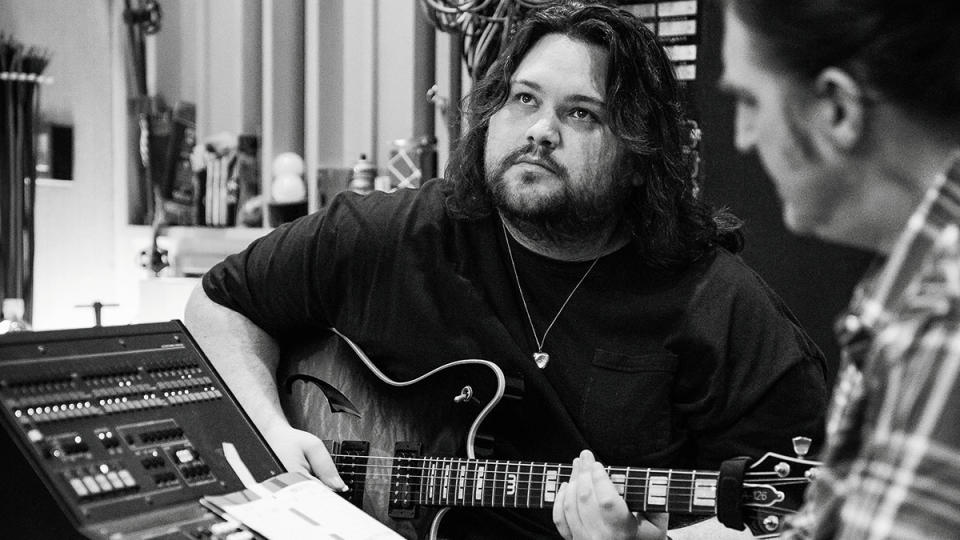
Much like the song itself, the solo graduates through its own stages of metamorphosis – from the octave bends at the start, the high string diads and E minor blues to the frenetic alternate picking and two-handed taps.
“I like to write my solos almost as if they’re their own little songs,” he explains. “On this one I was really trying to accentuate that rhythm without going right into the main solo first. It introduces that section without throwing the listener off the beat. I didn’t want to just throw a bunch of stuff on top of it – I wanted to lull people into the rhythm and then let the solo take over! It ebbs and flows in a way that tells a story – it’s not just wank the whole time.”
But of course, all lead guitar players tend to have that devil on their shoulders, and Wolfgang certainly is no exception. “Oh, there’s plenty of wank near the end, for sure,” he laughs, adding, “like all good solos should have!”
If the opening riff to Like A Pastime sounds almost like a CD skipping, that’s because it was written while the guitarist had been listening to Swedish tech-metal and trying to explain the concept of polyrhythms to his fiancée. He still has that initial demo on his phone and plays it to TG just to illustrate how big ideas can spring from the most unlikely of places.
“I had been listening to the new Meshuggah album and was trying to tell her how much I like it,” he recalls. “I was saying stuff like ‘Listen to how they do this on top of other stuff like that, isn’t that so cool?!’ And she was like, ‘I have no idea what the hell you’re talking about!’
“So I had this idea to bring her into my studio and ended up recording this one-minute-long demo. The early title for it was ‘Polyrhythm’! I just wanted to show her how guitars and drums could lock in together playing different rhythms, and it ended up being a really fuckin’ good song.”
The track is also notable for the staccato harmonised lines that show a different side of Wolfgang’s creative personality, this time in the form of an “almost new wave kind of thing”.
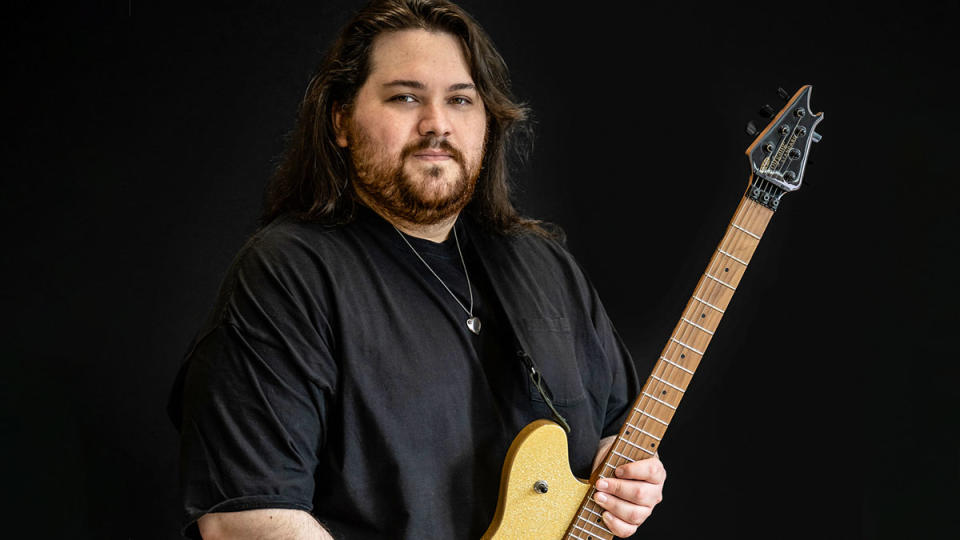
Describing himself as a “songwriter first and foremost”, it was a piece that simply didn’t call for any lead guitar stunts. Despite the largely overwhelmingly positive reaction to the single, he’s aware of a vocal minority hoping for more fretboard pyrotechnics, and rightfully points out there’s always a time and place for such things.
“There were a couple of people who were disappointed, but not every song needs a solo,” notes Wolfgang. “Solos are fun but you need to respect the song. If you listen to a song just for the 20 seconds after the second chorus, come on, that’s kinda disrespecting the song!”
Other highlights from the album include Miles Above, which thickens out A-string powerchords with the lower fifth interval on the E string (“I always heard that trick in Weezer riffs, it’s almost like an inversion”), and I’m Alright, which employs layered arpeggios to set the stage for the honky-tonk pianos and octave chords of its “classic-sounding” chorus.
But one of the album’s biggest guitar hero moments arrives in the form of Take A Bow, which starts with a suspenseful chord that descends one note at a time and eventually builds into one of the most epic solos we’ve heard from Wolfgang thus far, tastefully milking notes from Bb Dorian in a way not dissimilar to David Gilmour and even nodding to the Van Halen Panama solo with its G-string bend and multiple taps higher up the neck…
Yeah, that G-string bend and tap was very much one of my dad’s moves, and it just ended up in what I do, too!
“Yeah, that G-string bend and tap was very much one of my dad’s moves,” he says, “and it just ended up in what I do, too! That song is very special to me. It all started with that opening idea, where I’m playing a chord and moving down on one of the strings. It’s very mature and moody for us.
“And the solo is also unlike anything I’ve done before. I was just sitting there jamming along to the riff on repeat and ended up crafting that whole thing, crescendo-ing with that tapping part. I was just following my ears and what felt right while sat there.
“Maybe if there is a David Gilmour connection it’s because of the gaps in between the notes and, like you said, that whole Dorian feel. If it sounds like a guy in a room with his eyes shut, that’s pretty much how it came about!”
Take A Bow is also notable for being the only track on the album to feature any of the historic instruments from the family collection – specifically, one of the most iconic guitars in the history of rock ’n’ roll.
“The Frankenstein was what I used on that solo,” Wolf says. “I was thinking about using it for a bunch of songs, but in the end it was only that solo because it meant a lot to me. I didn’t even just use the Frankenstein, I had it plugged into my Dad’s original Marshall head and cabinet… so it was exactly what he used for the early Van Halen stuff. I think you can hear it’s that tone.
“Everything else was done through my 50-watt 6L6 5150III through a 4x12, the exact same head and cab I used at the Taylor Hawkins shows – which, for some reason, on tape I named ‘Noel’ and ‘Liam’ at the Wembley gig! And, believe it or not, those clean guitars at the beginning are my new SA-126, not a Tele or single-coil guitar. Which goes to show how versatile this guitar is – it doesn’t even have a split-coil mode. I was using my neck pickup and we added a little bit of reverb, that was it!”
Speaking of which, the guitarist’s new SA-126 signature guitar (referencing his father’s birth date, much like the 1991 Van Halen instrumental 316 was named to celebrate Wolfgang’s arrival) is now slated for a 2024 release.
Wolfgang describes his third prototype in Tobacco Sunburst as “the sound of Mammoth II” given that it was used for the riffs and leads heard every track – except for the aforementioned Take A Bow solo. There is no definitive date on the release but the guitarist is able to confirm: “Burst and Stealth Black will most likely be among the different finishes”.
Matt Bruck has also confirmed, “Ed left lots of ideas”, and teased a 24-fret Wolfgang model as well as hardtail options, the former of which can be seen in Mammoth VH co-guitarist Jon Jourdan’s hands in the Another Celebration… video. While the SA-126 is very much Wolfgang’s priority right now, there are plenty of exciting things in the works.
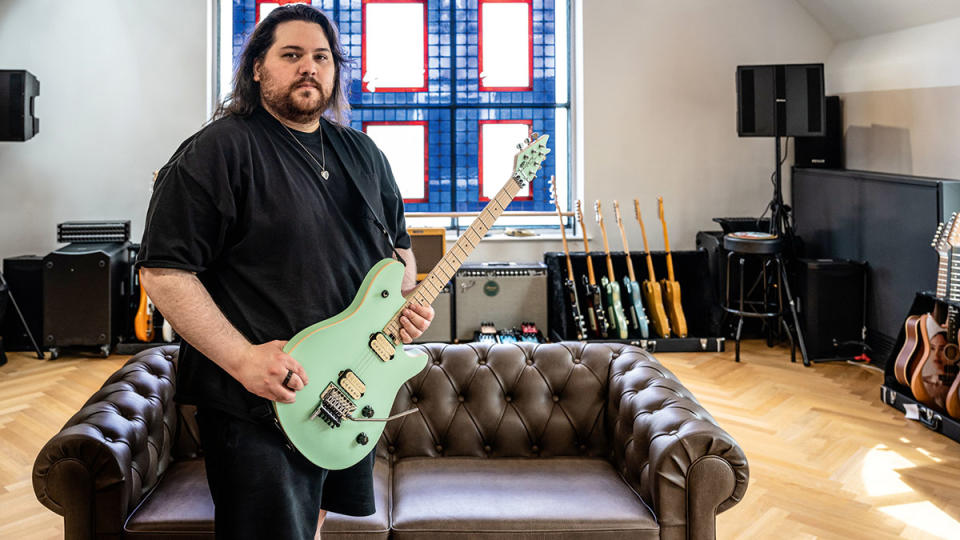
“We take it very seriously,” he says, of his duties overseeing the family brand and continuing the legacy. “I’m in meetings all the time with the higher-ups at Fender. We have a long-planned future. There were so many ideas that my dad left us, as well as ones me and Matt are coming up with, like the SA-126. There’s so much in store.
“It couldn’t be in better hands with Matt also in charge. He’s so important, so brilliant and so smart. He’s been working for the brand since the beginning. I’m just there to help make sure everything’s happening properly and being there because that’s what my Dad wanted.”
There has also been excitement over the new EVH collaboration with Boss, reimagining Eddie’s favoured SDE-3000 delay rack in pedal form, with Eddie’s own settings included.
“It’s an incredible pedal,” Wolfgang smiles. “Matt worked very, very hard on making sure it was an absolute perfect recreation of my dad’s original rack settings. I think Pete Thorn did a wonderful job demonstrating what that pedal is capable of in the promotional video. I’ll definitely add it to my ’board at some point for some fun.”
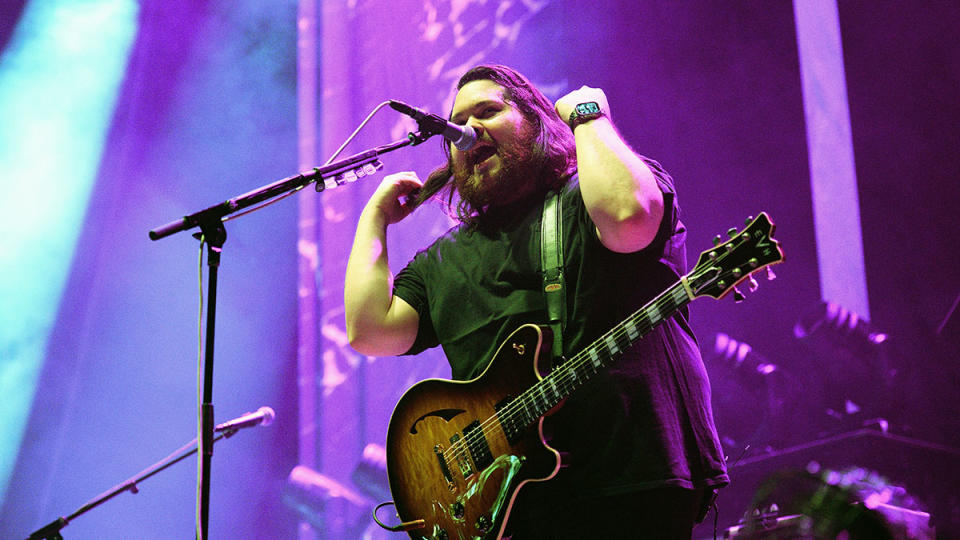
But anyone hoping to hear Wolfgang engaging those classic sounds for covers of Panama, Hot For Teacher and On Fire – as he did at the two Taylor Hawkins tribute shows – would be advised not to hold their breath.
As sad as it may be for a lot of fans, Wolfgang sees little chance of a Van Halen reunion tribute show or tour to honour his father. It is what it is, he shrugs.
I feel like I got my closure when I played the Taylor Hawkins tributes
“Unfortunately, with the way Van Halen operates and has operated, I don’t think it’s possible,” he admits. “With Foo Fighters and what they pulled off with the Taylor Hawkins tributes, the whole organisation from the ground up is very rooted in not too much personnel.
“With Van Halen and all of the history behind it, there may be a bit too much of that to be put aside for what should happen. Personally, I feel like I got my closure when I played the Taylor Hawkins tributes, because – at least just for me – they were just as much about my dad as they were Taylor.”
Joe Satriani – the man who at one point was mooted to play guitar in any Van Halen tribute event or tour – was so impressed by Wolfgang’s performances at the Taylor Hawkins concerts that he counted himself out of the running and admitted that no one but Wolfgang should be up there playing those songs. “That was very kind and sweet of him,” Wolfgang says. “Joe is a wonderful guitar player that can pretty much do anything.”
When he launched Mammoth WVH, Wolfgang vowed that with this band he would never play Van Halen songs – a vow he intends to keep. That said, he expresses pride in how he performed those songs at the Taylor Hawkins shows.
“If there was ever any time to do it, it was then,” he says. “And I was happy that I found the strength to pull it off, because I wasn’t sure if I was going to be able to do it. But man… It happened and I’m very happy I did it. Panama was so fun to play. Obviously I’m intimately familiar with the music, but I never knew how to play that stuff. I had to learn all of it in the month building up to the first show.
On paper, Hot For Teacher would never have been a successful single! What kind of hit starts with a drum solo into a guitar solo for a minute and a half?
“Hot For Teacher is another example of that clever rolling tapping thing. It’s not just tapping up in one direction, barring in one place. It moves up and down on the same string before moving onto the next. And then it goes into that boogie riff. On paper, that song would never have been a successful single! What kind of hit starts with a drum solo into a guitar solo for a minute and a half? It’s pretty funny…
“I guess things like that came really natural to me because I grew up around all that stuff. And On Fire was a blast – the leads are almost like warm-up at points when you’re climbing up those scales really fast. I was very grateful for the opportunity to be part of those celebrations – it meant a lot! I got a lot of my feelings out when we did those shows. That’s what I’ve come to terms with…”
He pauses for a brief moment before stating in conclusion: “When it comes to Van Halen, there’s too much that isn’t quite right. Some things are just the way they are, unfortunately. But right now, it’s all systems go with my own band.”
Mammoth II is released on August 4 via BMG.

